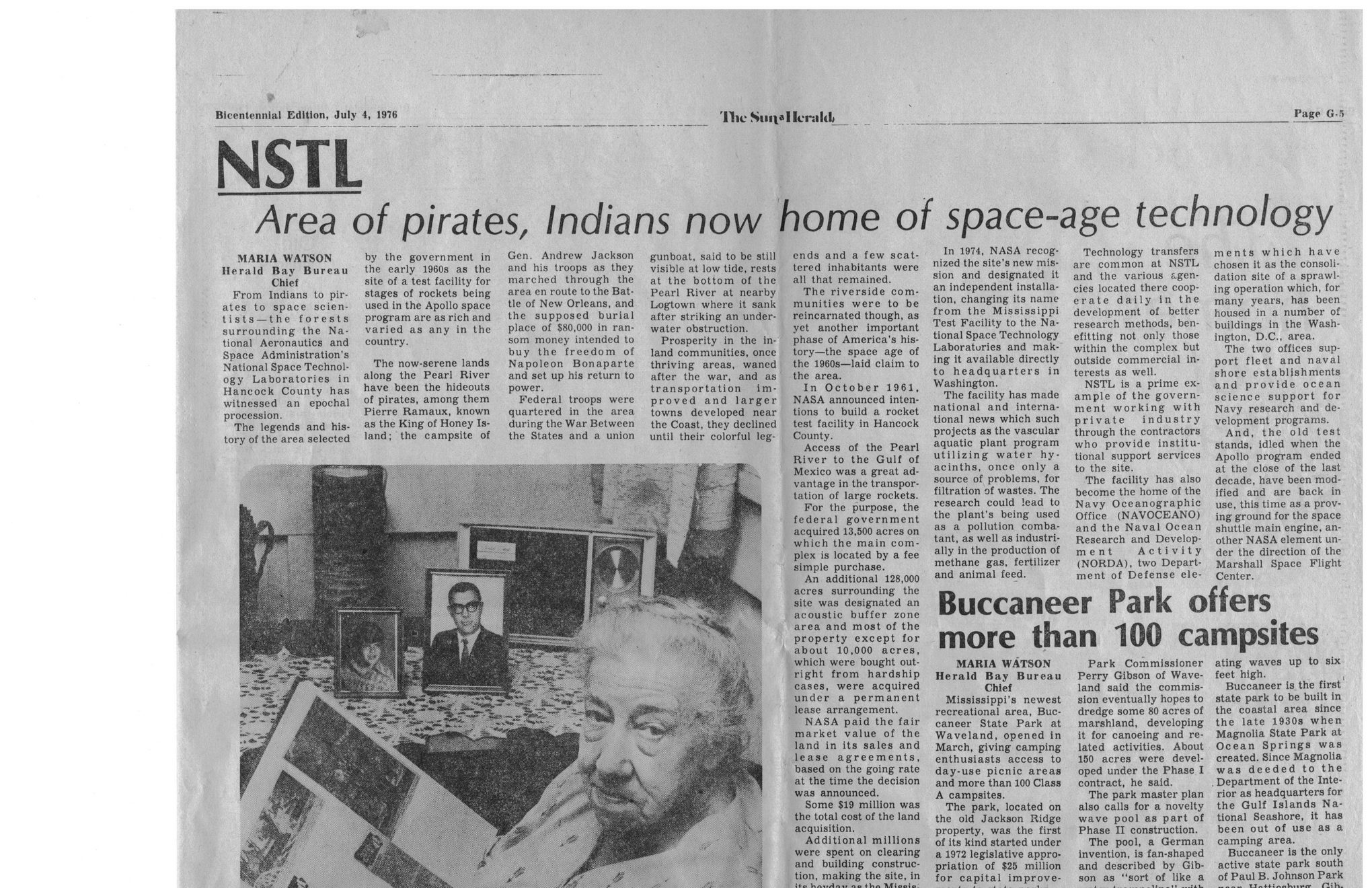This text was obtained via automated optical character recognition.
It has not been edited and may therefore contain several errors.
Bicentennial Edition, July 4, 1976 The Sllll®! Icttllil PaKe G'5 NSTL Area of pirates, Indians now home of space-age technology MARIA WATSON Herald Bay Bureau Chief From Indians to pirates to space scientists — the forests surrounding the National Aeronautics and Space Administration’s National Space Technology Laboratories in Hancock County has witnessed an epochal procession. The legends and history of the area selected by the government in the early 1960s as the site of a test facility for stages of rockets being used in the Apollo space program are as rich and varied as any in the country. The now-serene lands along the Pearl River have been the hideouts of pirates, among them Pierre Ramaux, known as the King of Honey Island; the campsite of Gen. Andrew Jackson and his troops as they marched through the area en route to the Battle of New Orleans, and the supposed burial place of $80,000 in ransom money intended to buy the freedom of Napoleon Bonaparte and set up his return to power. Federal troops were quartered in the area during the War Between the States and a union gunboat, said to be still visible at low tide, rests at the bottom of the Pearl River at nearby Logtown where it sank after striking an underwater obstruction. Prosperity in the inland communities, once thriving areas, waned after the war, and as transportation improved and larger towns developed near the Coast, they declined until their colorful leg- ends and a few scattered inhabitants were all that remained. The riverside communities were to be reincarnated though, as yet another important phase of America's history—the space age of the 1960s—laid claim to the area. In October 1961, NASA announced intentions to build a rocket test facility in Hancock County. Access of the Pearl River to the Gulf of Mexico was a great advantage in the transportation of large rockets. For the purpose, the federal government acquired 13,500 acres on which the main complex is located by a fee simple purchase. An additional 128,000 acres surrounding the site was designated an acoustic buffer zone area and most of the property except for about 10,000 acres, which were bought outright from hardship cases, were acquired under a permanent lease arrangement. NASA paid the fair market value of the land in its sales and lease agreements, based on the going rate at the time the decision was announced. Some $19 million was the total cost of the land acquisition. Additional millions were spent on clearing and building construction, making the site, in 5fo oo IVin In 1974, NASA recognized the site’s new mission and designated it an independent installation, changing its name from the Mississippi Test Facility to the National Space Technology Laboratories and making it available directly to headquarters in Washington. The facility has made national and international news which such projects as the vascular aquatic plant program utilizing water hyacinths, once only a source of problems, for filtration of wastes. The research could lead to the plant's being used as a pollution combatant, as well as industrially in the production of methane gas, fertilizer and animal feed. MARIA WATSON Herald Bay Bureau Chief Mississippi's newest recreational area, Buccaneer State Park at Waveland, opened in March, giving camping enthusiasts access to day-use picnic areas and more than 100 Class A campsites. The park, located on the old Jackson Ridge property, was the first of its kind started under a 1972 legislative appropriation of $25 million for capital improve- Technology transfers are common at NSTL and the various agencies located there coop-erate daily in the development of better research methods, ben-efitting not only those within the complex but outside commercial interests as well. NSTL is a prime example of the government working with private industry through the contractors who provide institutional support services to the site. The facility has also become the home of the Navy Oceanographic Office (NAVOCEANO) and the Naval Ocean Research and Develop-ment Activity (NORDA), two Department of Defense ele- Park Commissioner Perry Gibson of Waveland said the commission eventually hopes to dredge some 80 acres of marshland, developing it for canoeing and related activities. About 150 acres were developed under the Phase I contract, he said. The park master plan also calls for a novelty wave pool as part of Phase II construction. The pool, a German invention, is fan-shaped and described by Gibson as ‘‘sort of like a ments which have chosen it as the consolidation site of a sprawling operation which, for many years, has been housed in a number of buildings in the Washington, D.C., area. The two offices support fleet and naval shore establishments and provide ocean science support for Navy research and development programs. And, the old test stands, idled when the Apollo program ended at the close of the last decade, have been modified and are back in use, this time as a proving ground for the space shuttle main engine, another NASA element under the direction of the Marshall Space Flight Center. ating waves up to six feet high. , Buccaneer is the first state park to be built in the coastal area since the late 1930s when Magnolia State Park at Ocean Springs was created. Since Magnolia was deeded to the , Department of the Interior as headquarters for the Gulf Islands National Seashore, it has been out of use as a camping area. Buccaneer is the only active state park south of Paul B. Johnson Park ___— niV>_ Buccaneer Park offers more than 100 campsites

BSL 1970 To 1976 Newspaper-Clippings-BSL-'70-'76-(14)